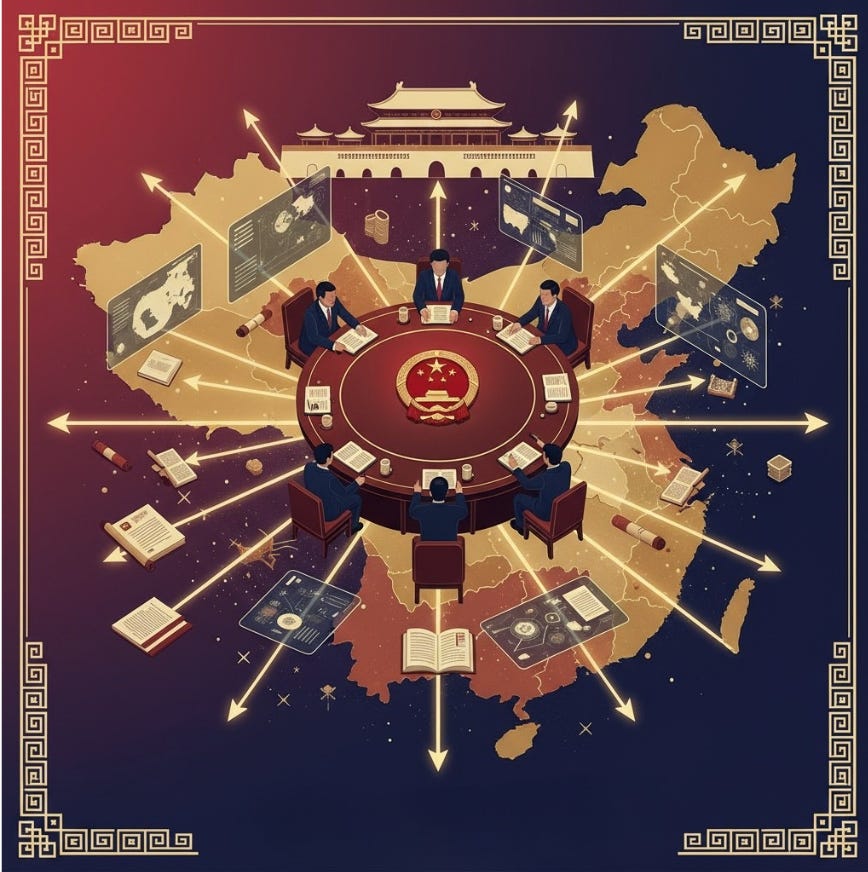Thursday Edition — The Command Center: How China Is Governed
How the Chinese government really works
Now that we’ve examined how leaders are selected through meritocracy (Tuesday’s edition) and how policy is developed through structured consultation (Wedneday’s edition), we can look at how those decisions are carried out.
At the top of China’s political structure sits the Politburo and its Standing Committee, the central command of the Communist Party. These two bodies translate policy into national direction. They manage the country’s priorities, coordinate ministries, and make the final decisions that shape China’s economy, security, and governance.
The Politburo has 24 members, and the Standing Committee currently has seven. Together, they guide the state, the military, and the economy. Their decisions define China’s direction for years, sometimes decades.
The Politburo: Setting National Direction
The Politburo oversees national policy. Its members include provincial leaders, ministers, military officials, and Party secretaries who manage key regions or sectors. They meet regularly to review reports, coordinate national plans, and decide how to handle major issues from economic growth to security and foreign affairs.
Policies do not begin inside the Politburo. Ideas and proposals are first discussed in the Chinese People’s Political Consultative Conference (CPPCC), where experts, professional associations, and representatives from the eight minor parties provide analysis and feedback. These discussions help identify social needs, technical issues, and policy gaps (See Wedneday’s editon for more details).
Policy discussions also pass through the National People’s Congress (NPC) and the Party Congress. The NPC reviews and approves laws and Five-Year Plans, while the Party Congress meets every five years to confirm leadership and set long-term national priorities. These institutions build consensus and define goals before proposals move to the Central Committee for refinement.
From there, recommendations pass to the Central Committee and are refined through Party working groups. The Committee reviews options, gathers data from ministries and local governments, and prepares policy drafts that align with national priorities (See Wedneday’s editon for more details).
The Politburo then examines these drafts, weighs their long-term implications, and decides which direction to take. Its Standing Committee finalizes those choices. Once decisions are approved, they are passed to the State Council, which carries them out through national ministries and regional governments.
This process keeps decision-making centralized but informed. It allows broad consultation through the CPPCC and the Central Committee, while ensuring that the Politburo maintains full control over the final outcome.
Once consensus is reached, policies are passed to the State Council for implementation. The Politburo does not execute policy; it provides direction and final approval. Its function is strategic, deciding what China will do, not how it will be done.
The Standing Committee: The Executive Core
Within the Politburo, the Standing Committee is the most powerful group. Its members meet weekly to decide issues that require coordination between ministries or provinces. Each member oversees a major area, economy, information, security, foreign affairs, and internal administration.
Issues are debated and decisions are made collectively. There are no public votes or debates. Once a decision is made, all members support it publicly. This unity is deliberate: it prevents factional conflict and keeps national direction consistent.
While the General Secretary (currently Xi Jinping) holds the top position, decisions are still made through debates and discussion among Standing Committee members. Every major decision passes through discussion and documentation. The process values discipline, predictability, and continuity over confrontation.
How the System Works
Information flows upward through a structured chain. The CPPCC, NPC, and Party Congress gather opinions, review plans, and set broad priorities. These recommendations, combined with data from ministries and local governments, move to the Central Committee for analysis and preparation before reaching the Politburo.
The Central Committee filters this information before it reaches the Politburo. When needed, the Standing Committee issues instructions that cascade back down through the same channels.
This structure resembles a command center. Communication is vertical, decisions are centralized. It ensures that once a plan is approved, every level of government moves in the same direction.
Cultural and Organizational Logic
Three cultural dimensions explain how this system functions effectively in China:
High Power Distance (GLOBE): Power is concentrated at the top, and leaders are expected to use it responsibly to deliver results. Authority brings obligation, not privilege. The Politburo’s authority depends on competence and outcomes, not popularity.
Particularism (Trompenaars): Rules can be adapted when outcomes benefit national stability. Policies are adjusted to meet changing conditions while maintaining the appearance of unity.
Hierarchy (Schwartz): The system assumes order is maintained through rank and duty. Each level knows its role and acts within clear boundaries, preserving coherence even during crises.
Hornby’s Archetypes and Leadership
Hornby’s archetypes help explain the behavioral style of China’s top leadership.
The North (Leader) archetype defines the Standing Committee, directive, goal-oriented, and focused on clear authority. The Blue (Guardian) ensures discipline and continuity, upholding Party rules and collective accountability. The West (Scholar) supports informed decision making through study, analysis, and data review.
Together, these archetypes describe a leadership system that values foresight, order, and knowledge. The North provides direction, the Blue maintains structure, and the West ensures decisions are reasoned and informed.
Why It Matters
The Politburo and its Standing Committee are the control tower of China’s political system. They provide consistent leadership across decades, allowing for long-term projects in infrastructure, technology, and economic reform.
This model prevents the frequent policy swings common in systems tied to election cycles. The trade-off is limited transparency, but the gain is continuity and stability. The system’s effectiveness depends on competence, discipline, and coordination, not electoral contest.
It is a form of centralized governance designed to make the state function predictably. For China, the Politburo and Standing Committee are the mechanism that keeps the country moving in one direction, even as the world changes around it.
Join us for more cultural perspective on TikTok and Youtube






Thanks, Way! Appreciate the information - I had no idea.